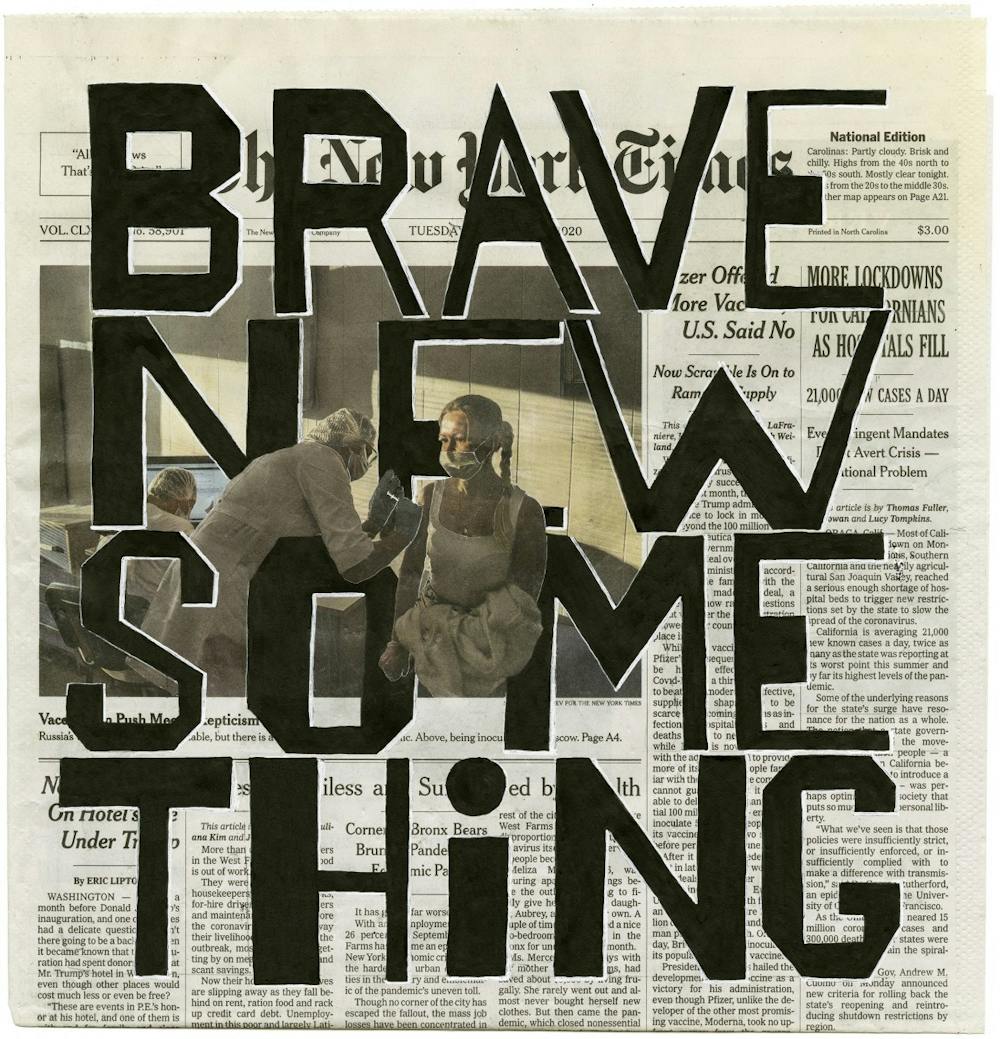When you think back to your time in quarantine, what comes to mind? For many, including Margaret Sartor, the artist behind “TORN: A Year that Changed Everything,” it was marked by constant anxiety about the events around us and uncertainty about the future. Throughout her daily peruse of the newspaper, Sartor began to annotate the articles and photos, expressing her “frustration… and shock” and imbuing the pages with her emotional reactions. Sartor described this practice as “giving voice to [her] interior battles,” and the resulting pages combined events and emotion, capturing the near universal mindsets of quarantine.
Sartor’s mixed media work is striking, with large statements overspreading cutouts from the New York Times. I found myself instantly drawn to her genuine reactions, often in black or white, that jump out at the viewer. They were simple, yet effective, reminiscent of my own reactions to past events. The collection showcased a passionate cycle of rage, hopelessness, excitement, and hesitancy. “WHAT THE F-CK” covers a photo from the Jan. 6 attack on the Capitol and “BRAVE NEW SOMETHING” overlays a cover page of a young girl getting her vaccine. When viewing Sartor’s pieces, it feels personal, like a text you may have received from a friend after watching the nightly news or a conversation over family dinner.
Unsurprisingly, many of her pieces were political, utilizing red and blue accents to reflect the deeply partisan environment that accompanied the election and the pandemic. In the pieces focusing on the Capitol riots and their aftermath, viewers were able to follow Sartor’s journey. After her initial shocked reaction, she comments on the longevity of white supremacy in America through two pieces. Over a series of accounts of the riots from journalists, Sartor writes “THAT WAS NOW, THIS IS THEN,” suggesting that the conflict seen at the Capitol has long been part of American culture. She follows this by writing “WE KNOW MORE THAN WE KNOW WE KNOW” over a Roxanne Gay piece about the need to stop striving for bi-partisanship. In these pieces, we see her approach the current events: a desire to understand root causes to effectively move forward. The mood of these pieces is not one of hopelessness, but rather anger, frustration, and a desire to find a reason for the calamity. As we see Sartor continue to grapple with these events, the mood shifts into something close to despair. Over an article from Feb. 2021 titled “Extremism From Whites Has Strong Roots in U.S.” Sartor writes, “I WAKE UP SCREAMING.” One of the most emotionally raw pieces in the collection, this work exemplifies the powerlessness many felt when faced with a broken system and despicable history. When combined, these works depict a steady decline in Sartor’s own emotional well-being.
Despite the challenges of the pandemic and political systems, Sartor’s collection is not without hope. Over an article detailing Rev. Raphael Warnock’s run for Senate she writes “GEORGIA ON MY MIND.” She outlines the letters in a mixture of blue and red, reflecting the close Senate race in the state and the importance of the race to everyone, regardless of political affiliation. Contrasting the other pieces that prioritize Sartor’s reaction, Rev. Warnock is the primary focus of this piece, his image overlapping the letters at times. In doing so, Sartor captures the feelings of the nation as everyone raptly followed the Georgia runoffs to see if Republicans would be able to maintain control of the Senate. Through the promotion of Rev. Warnock, this piece exudes a feeling of hope and excitement, greatly contrasting others in the collection.
Sartor described the collection as “a cumulative portrait of time” covering the highs, lows, and “common hopes” of the year. She succeeds in her vision, creating work that encourages viewers to look back at the past and recall their own emotions with each event. In the article that served as the collection’s namesake, Sartor writes “HOW TO MOVE ON” questioning where we can go from here. While “TORN: A Year that Changed Everything” may not give you an answer to this question, the series inspires careful reflection and reminds us all of our own path throughout this past year.
“TORN: A Year that Changed Everything” is currently on display as limited edition archival fine art prints produced through a collaboration with Margaret Sartor and photographer Alex Harris at PS 118 Gallery & Event Space in Durham, NC.
Get The Chronicle straight to your inbox
Sign up for our weekly newsletter. Cancel at any time.

